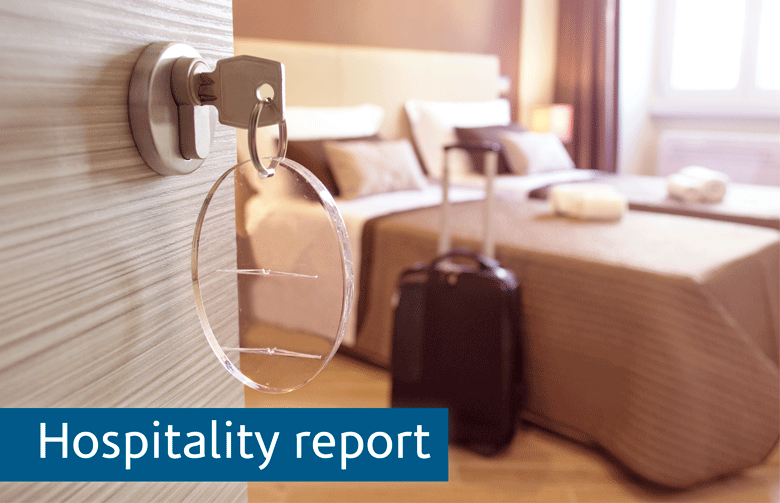

The hospitality industry in the Middle East did not deliver the most positive performance in 2018, with all key metrics in decline. According to US-based hotel market data and benchmarking company STR, hotels in the Middle East saw occupancy dip 0.5 per cent to 64.6 per cent, while the average daily rate (ADR) declined 5.2 per cent to $155.45 and revenue per available room (RevPAR) decreased 5.7 per cent to $100.45.
Director of boutique hospitality, leisure and real estate management consultancy TRI Consulting, Christopher Hewett, says he expects there to be a shift from “occupancy addiction to RevPAR” in the near future.
 “The region’s historical addiction to occupancy is a by-product of the past, when demand levels generally exceeded supply, resulting in strong market-wide occupancy levels,” he says.
“The region’s historical addiction to occupancy is a by-product of the past, when demand levels generally exceeded supply, resulting in strong market-wide occupancy levels,” he says.
However, despite improved revenue management practices, a preoccupation with occupancy continues.
Supply growth
In addition, supply has increased in the past year, with the Middle East reporting a 21 per cent year-on-year increase in the number of rooms under construction (127,115 rooms) through January, according to STR pipeline data.
Hewett explains: “With the growth in supply and competition, hoteliers are starting to shift focus from purely filling rooms to maximising revenues through a RevPAR focus. This entails sacrificing high occupancy levels for stronger ADR performance. While this can be challenging in a market where ADRs are falling, hoteliers need to start focusing on yielding their own inventory rather than just watching their competitors.”
In fact, the number of competing companies in the market is being reduced as a result of ongoing industry consolidation. In the past 12 months, InterContinental Hotels Group has acquired Six Senses, Two Roads Hospitality has been taken over by Hyatt, and Accor has acquired Movenpick.
This acquisition trend is likely to continue. Industry insiders expect some regional brands to be snatched up by larger international chains hoping to further cement their position in the Middle East.
Owner-operator relations
While many operators, when announcing mergers, explain that owners are happy with the consolidation and the benefits it offers them, experts are not so sure. The market in this region is slowly maturing and, with the launch of newer boutique operators, owners have more investment options. Brands must stay ahead of the curve and liaise with their owners or stand the risk of being deflagged.
Hewett says: “The increased discussion of reflagging, deflagging or franchising is being driven by a number of key factors, such as softer market conditions, market life cycle, mergers of hotel companies and more knowledgeable owners and asset managers.”
He explains that most markets in the region are maturing, leading to an evolution of the hotel sector. “In general, the softer market conditions are a key driving force behind these discussions as owners are experiencing reduced returns. Furthermore, owners are starting to question the value operators bring to their assets and are exploring other operating models,” he adds.
“The region in general is more relationship-based than other parts of the world, and with the higher proportion of private investors to institutional investors, the relationship between owner and operator is critical. With large hotel management companies consolidating and growing with new brands, the personalisation and attention to owners is reducing, impacting the relationship foundation of the agreements,” he continues.
“This is causing owners to reassess their partnerships and look at alternatives, particularly as an increasing number of properties reach the end of their initial term.”
Franchise agreements
The other way in which owners are looking to renegotiate their relationships is through the slow movement towards franchising and third-party operators. Franchises are popular elsewhere in the world, but until a few years ago, the Middle East had lagged behind as a result of market immaturity and a lack of operational knowledge.
“However, in recent years, we have witnessed a greater appetite on behalf of operators to offer franchise agreements,” Hewett notes. “This is due not only to greater confidence in owners’ abilities to manage their properties effectively, but also provides operators with increased speed of brand expansion.”
 Marriott International, for example, sees the potential of franchises. Chief development officer for the Middle East and Africa at Marriott International, Jerome Briet, says while the majority of the operator’s properties are managed, it currently has more than 50 franchised properties operating in the region.
Marriott International, for example, sees the potential of franchises. Chief development officer for the Middle East and Africa at Marriott International, Jerome Briet, says while the majority of the operator’s properties are managed, it currently has more than 50 franchised properties operating in the region.
He adds: “We see potential in that number growing. There are a lot of benefits for an owner under the franchise model. For us, as operators, it is important to understand the owner’s vision and experience in managing hotels themselves before signing any franchise deals.”
The benefits of franchise agreements are indeed plentiful, Hewett says. Owners have shorter terms and greater control over the operation and asset, while also paying lower fees. Owners also benefit from enhanced gross operation profit, typically of between 5-10 percentage points. Meanwhile, the potential benefits for operators include a rapid increase in the brand footprint, as well as reduced operational requirements.
An offshoot of the traditional hotel investment and operational business is branded residential projects. However, industry experts are divided about whether this is still a feasible way to guarantee return on investment.
“The inclusion of branded residential within hotel projects has been a popular model in Dubai over the past 10 years, as developers benefit from early-stage equity injection into their projects, reducing their need for financing,” says TRI’s Hewett.
“While Dubai has been the main market for this model, other emirates and GCC countries are witnessing an increasing number of projects following this model. However, as the region faces weakening real estate conditions, the appeal of this model as a way of increasing equity infusion for projects is reducing.”
Continued interest
Real estate prices were at their peak five years ago, and some hoteliers have suggested that it is now a struggle to offload branded residential stock. Operators, on the other hand, see merit in the business, despite the associated operational and legal issues, because it allows them to charge a branding fee or commission on the units.
Marriott’s global branded residential portfolio is expected to grow by more than 70 per cent over the next four years. It currently operates three branded residential properties in the region and is on track to more than double its residential portfolio, with eight projects scheduled to open by 2022.
Briet says there is growing demand for branded residences in the region. “We are seeing that consumers are increasingly seeking residences in communities that offer a convenient lifestyle and an array of amenities and services, while developers seek to differentiate and elevate their products with trusted brands,” he explains. “In addition, branded residences, when built with a hotel, allow the developer to reduce the project’s debt by capitalising on the margins realised on the residential sales. It is therefore typically a win-win situation.”
Another operator keen to enter the branded residential space in the region is hotel management company SBE, in which Accor acquired a 50 per cent stake a year ago. The operator recently revealed it is launching a branded residential element to its SLS Hotel project in Dubai. SBE is already firmly embedded in the residential space on a global level, with 1,300 branded residential units sold to date, valued at $2bn, and another $1.8bn-worth in the pipeline.
Looking ahead
While there are various opportunities for the market to take advantage of, hoteliers need to band together to overcome the challenges caused by overall market conditions and increased supply. Hewett says there is now a trend towards collaboration rather than competition. The latter, he says, caused a focus on occupancy and drove the practice of last-minute rate dropping in certain sub-markets. This rate war is harming hotels, Hewett adds.
“Rather than continuing this competitive approach, hoteliers in certain sub-markets need to collaborate and compete together against other sub-markets in other cities. When demand levels are high, hotels should work together to collectively increase rates rather than reducing them, thus improving their yields on demand.”
By Devina Divecha
Hospitality report
You might also like...

Red Sea Global awards Marina hotel infrastructure
18 April 2024

Aramco allows more time to revise MGS package bids
18 April 2024

Morocco tenders high-speed rail project
18 April 2024
A MEED Subscription...
Subscribe or upgrade your current MEED.com package to support your strategic planning with the MENA region’s best source of business information. Proceed to our online shop below to find out more about the features in each package.






